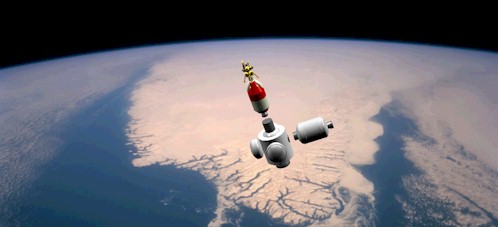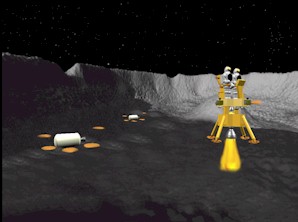|



|


Transportation
System
In
order to carry out manned Lunar missions without having to develop a
massive Saturn-V size launch vehicle, the Earth-Orbit Rendezvous method must be
used. Using this technique, the Trans Lunar Injection Vehicle (TLIV), the
Lunar Orbit/Trans Earth Injection Vehicle (LOTEIV), and the Lunar Hopper (LH)
will be assembled into a single spacecraft, piecemeal in Earth
orbit by the Neptune 4000
launch vehicle. Since the entire Lunar mission hardware will weigh
approximately 60,000 pounds (27,211 Kg), seven Neptune 4000 launches will be required for each mission.
Trans
Lunar Injection Vehicle (TLIV)
The weight of the TLIV including the weight of the landing and return
system will be approximately 60,000 pounds (27,210 Kg) of which
approximately 45,000 pounds (19,974 Kg) will be propellant weight. Five
Neptune 4000 flights will be required to launch a fully fueled TLIV. One
more launch will be needed to place the reentry capsule and Lunar Hopper
into Earth orbit. The
first flight will place a special Neptune 4000 second stage into orbit with one
propellant tank containing 20% of the required propellants. Once on orbit,
the main second stage propellant tanks will be jettisoned and deorbited.
The restartable second stage engine and TLIV tank adaptor with attached
propellant tank section will remain in
orbit. Four more flights will be made to deliver the other four filled propellant
tanks to the TLIV section. These will be docked autonomously with the TLIV tank adaptor. The
required propellant tanks will be launched by a Neptune 4000 rocket with a special third
stage called the Autonomous Cargo Delivery Vehicle (ACDV). The ACDV will
be similar to the Russian Progress cargo delivery vehicle. Like the
Progress, it will have autonomous docking capability.
Lunar
Orbit Trans Earth Injection Vehicle (LOTEIV)
The actual configuration of this vehicle will depend on whether the Lunar
mission is a two person manned return mission or an unmanned cargo mission. In both
cases, the same vehicle will be used to place the payload into Lunar
orbit. For unmanned cargo missions, the cargo will be staged in Lunar Obit
and landed at the Lunar Station site using its own landing system. For
manned missions, a larger propellant tank will be included and the
same vehicle will be used to send the attached manned reentry capsule and
its occupants back to earth for direct Earth atmosphere reentry.
Reentry
Capsule
For manned missions, the two Lunar explorers will ride to and from the
moon in a small Reentry Capsule. The Reentry Capsule will be equipped with
10 days of life-support supplies. The Lunar Explorers will be launched into
Earth orbit with the Lunar Hopper as soon as the transfer vehicle has been assembled. Just prior
to the trans lunar injection burn, the capsule will be docked with the
LOTEIV. The two person reentry capsule is based on the Apollo capsule design,
a design that has been proven for return missions from the Moon. In
addition, aerodynamic data is available. The reentry capsule is also
fitted with Remora space suit docking equipment and Remora* space
suit shrouds. On return from the Moon, the capsule will follow a ballistic reentry
trajectory and land by parachute in the Pacific Ocean near the Trans Lunar
Research Pacific Launch Complex or the TLR South Pacific island spaceport.
Lunar
Habitat Canister
Each manned mission will include at least two unmanned cargo missions. The
most important unit to be delivered will be the Habitat Canister (HC).
Each Habitat Canister will be approximately 10 feet (3 m) in diameter and
20 feet (6.1 m) long and weigh approximately 6,000 pounds (2721 Kg). The
HC's will contain power systems (fuel cell backup and solar), a
life-support system, oxygen, nitrogen, food, water, and a science
laboratory. It will have a 30-day supply for two Lunar explorers. The HC's
will be landed at the Lunar Station site with forward mounted rockets and
ACS system with their landings cushioned by an airbag system. The airbag
system will also be used to place the HC in the proper orientation on the
surface.
Supply
and Hardware Canister
In addition to the Habitat Canisters (HC's), a Supply and Hardware Canister (SHC)
will be utilized to land supplies, agricultural, and manufacturing
equipment. Supplies include liquid nitrogen, food, and water. These
supplies will be needed until indigenous Lunar water is found and is able
to be processed. In addition, oxygen manufacturing equipment, a
lightweight bulldozer or other type of earth mover, and an Agricultural
Canister (AC) will be landed. Lunar agriculture experimentation will begin
within 30-days after the base is occupied. SHC's can also be sent in the
event of an emergency.

Lunar Hopper Landing
in Shackleton Crater
Lunar
Hopper
For manned missions, the Lunar Orbit Rendezvous method will be used to get
the Lunar explorers to and from the Lunar Surface. This method greatly
reduces the overall required mission propellant weight. It produces a
weight saving of as much as 40% over the weight requirements for a Lunar
Direct landing. Since even before the manned flight is initiated, the Lunar
Station will already have life support equipment (Habitat Canister) and supplies, the
ascent/descent vehicle (the Lunar Hopper) can be made lightweight and simple. The TLR Lunar
Hopper (LH) is a two person, two-stage open cabin vehicle. Weighing only 2,600 pounds
(1179 Kg), the Lunar Hopper will include separate ascent and descent
liquid rocket engines and a single attitude control system. Before the
descent to the Lunar Station, the Lunar
explorers will enter their Remora space suits* through two hatches
in the side of the reentry capsule, detach their Remora suits from the reentry
capsule space suit docking collars, and pull themselves into the
Lunar Hopper which is attached by an adaptor to the forward end of the
reentry capsule. They will then detach and ride the Lunar Hopper, open to
the vacuum of space, to the Lunar surface. The Remora partial hard space
suits are designed to allow their wearers to enter and exit through a
chest hatch/docking collar. Once at the Lunar Station site, they can
dismount the Lunar Hopper, walk to the Habitat Canister, attach their
suit's docking collar to the HC's docking collar, pressurize the docking
collar tunnel, open the HC' hatch and the space suit chest hatch, squat
down, and crawl into the HC. The Remora space suits remain outside, pressurized,
and attached to the Habitat Canister. This system eliminates the
need for a special airlock, eliminates most air loss, and prevents the
transfer of Lunar dust into the HC.
Return
to Earth
While the Lunar explorers are at the Lunar Station, the LOTEIV will remain
orbiting the moon, unmanned. Its internal guidance system will
automatically maintain its orbit. When it is time for the Lunar explorers
to return to earth, they will mount the Lunar Hopper and launch into Lunar
Orbit. The descent section will remain on the Lunar surface. The ascent
stage of the Lunar Hopper will weigh less than 1,000 pounds (454 Kg). The
Lunar Hopper will rendezvous with the LOTEIV and the crew will transfer to
the reentry capsule through their Remora space suit docking collars. After
they transfer, the Lunar Hopper will be deorbited. Later, the LOTEIV
engines will be fired to return the Reentry capsule to Earth.
For
Lunar Station details, click here!
|
xxxxxxxxxxxxxxx
Win
a Trip to Space MISSION TRANSPORT LUNAR
STATION INTERNAL
R&D GRANTS
PAPERS
FACILITIES MOONSHOP
CONTACT
HOME
|





